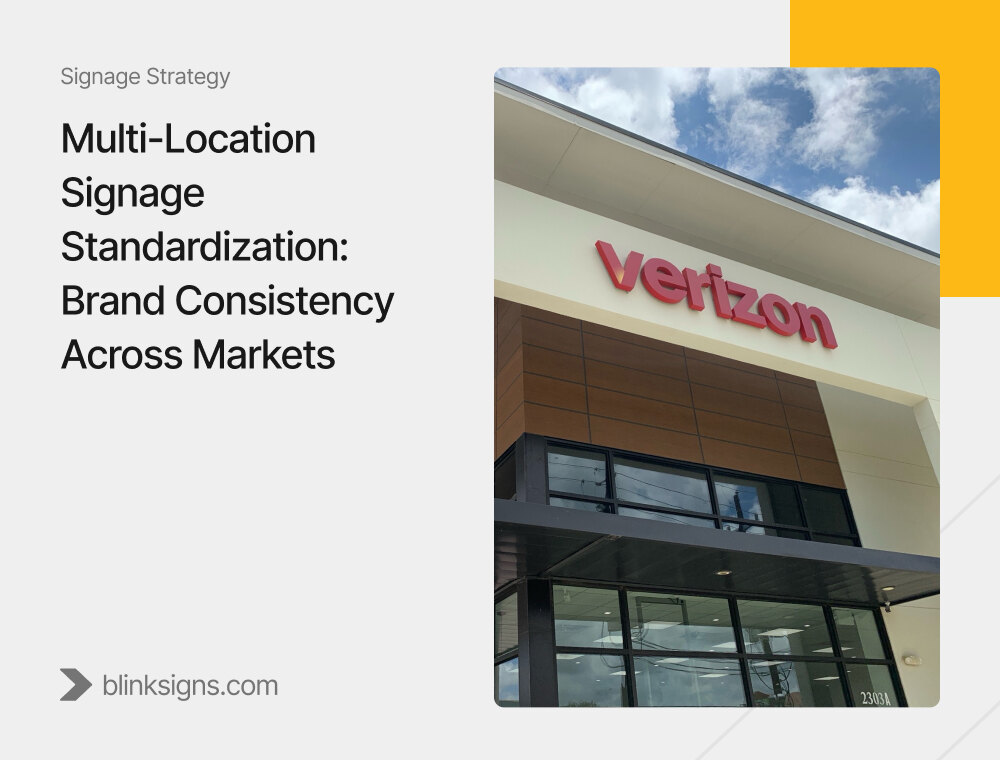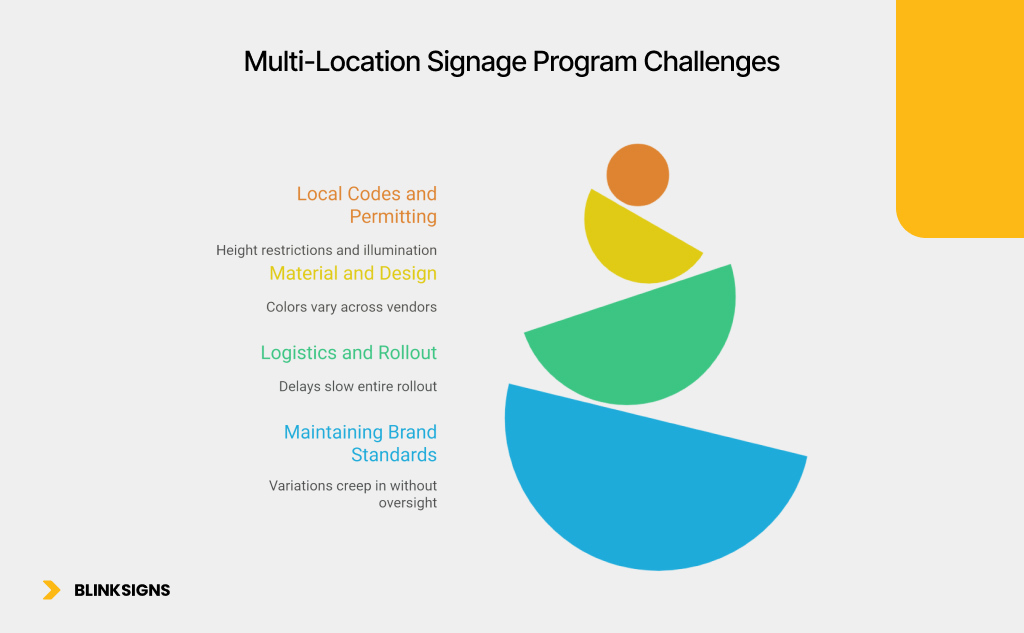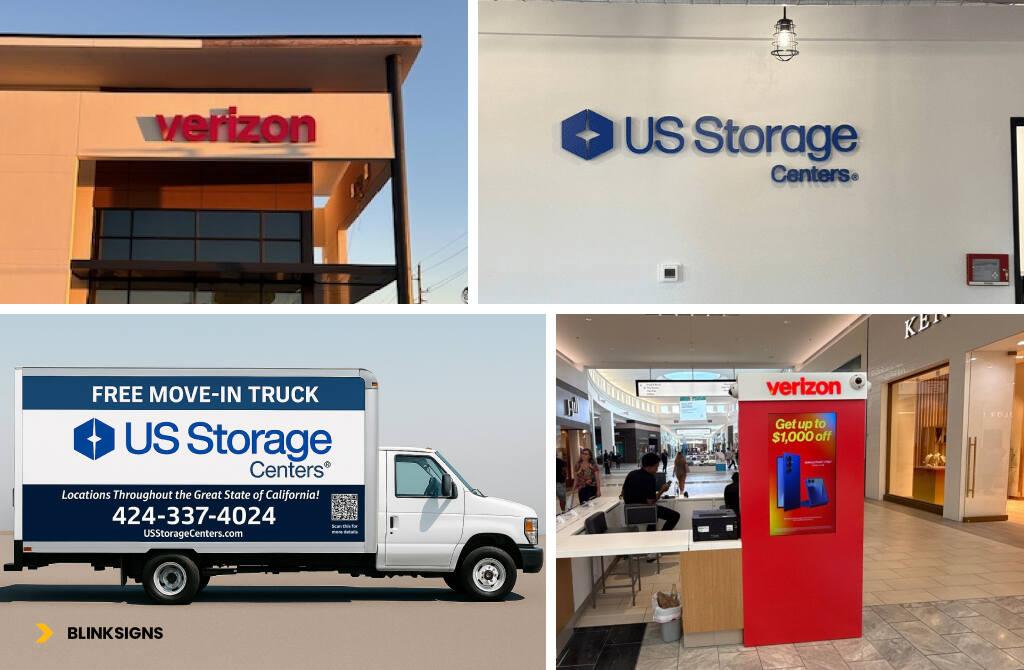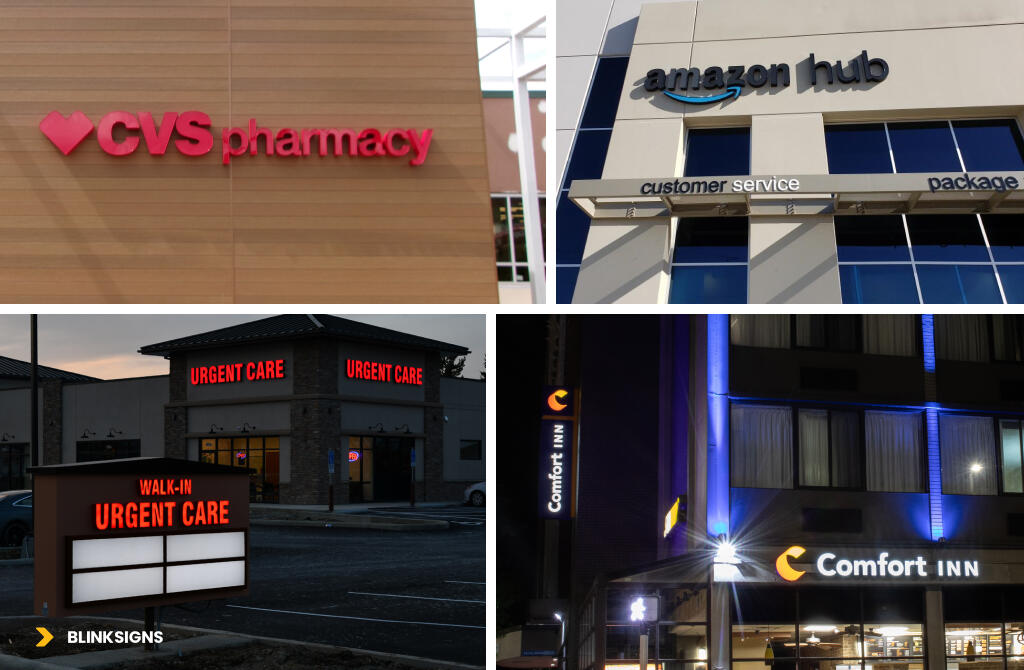
Multi-Location Signage Standardization: Brand Consistency Across Markets
Why Signage Consistency Matters Across Markets
For businesses that operate in multiple cities—or even nationwide—signage is more than a marketing tool. It’s the most visible expression of your brand, a promise of consistency wherever customers find you. But when signage looks different from one location to another—whether in color, size, or finish—it undermines brand credibility and creates confusion.
At BlinkSigns, we believe multi-location signage standardization is not just about keeping logos uniform—it’s about protecting brand equity, customer trust, and operational efficiency. Whether you’re managing a retail chain, a healthcare network, or a nationwide franchise, standardizing signage across markets ensures your brand looks, feels, and performs the same everywhere.
Why Standardization Matters in Multi-Location Signage
Customers expect familiarity. When they walk into your location in Cleveland or Dallas, they should feel the same sense of recognition, trust, and professionalism. Standardized signage delivers that continuity while also streamlining operations.
- Brand Equity: Consistent signage reinforces credibility and professionalism.
- Customer Experience: Familiar visuals reduce confusion and build trust.
- Operational Efficiency: Centralized signage programs save time, reduce costs, and eliminate duplication.
- Compliance Assurance: Standardization ensures every site meets ADA and zoning requirements without variation.
Without a structured approach, brands risk fragmented identities. Standardization ensures that signage becomes an asset for growth, not a liability across markets.
Key Challenges of Multi-Location Signage Programs

Multi-Location Signage Program Challenges
Navigating Local Codes and Permitting
Every city has its own rules, from height restrictions to illumination limits. A sign that’s permitted in Texas may require modifications in California. Historic districts often demand special approvals, while coastal regions may enforce stricter engineering standards for wind loads.
Challenge: Ensuring brand consistency while meeting local zoning codes and municipal regulations.
Material and Design Consistency
Colors that look perfect at headquarters may vary when fabricated across multiple vendors. Fonts, finishes, and materials can differ if not carefully standardized. Even minor inconsistencies erode brand recognition.
Challenge: Maintaining fabrication quality, ADA compliance, and sustainable material standards across all markets.
Multi-Market Logistics and Rollout Timelines
Coordinating signage across dozens—or hundreds—of locations requires precise scheduling, local vendor management, and compliance with varying state regulations. Delays at one site can slow an entire rollout.
Challenge: Aligning installation coordination, multi-state permitting, and project management for on-time execution.
Maintaining Brand Standards Across Markets
Franchises and multi-site enterprises often struggle to keep signage aligned with corporate brand guidelines. Local variations creep in without oversight—different logo sizes, off-brand colors, or inconsistent finishes.
Challenge: Enforcing brand compliance audits and using digital guideline libraries to ensure every sign matches corporate identity.
Signage Types That Require Standardization Across Locations

Signage Types That Require Standardization Across Locations
Exterior Signage
Exterior signs are often the first touchpoint for customers. Consistency here is crucial for recognition.
- Monument Signs: Standardizing size, stonework, and finishes across all markets.
- Pylon Signs: Ensuring uniform structure, height, and tenant panels in shopping centers.
- Channel Letter Signs: Matching fonts, LED color temperatures, and mounting styles.
Interior Signage
Once customers step inside, interior signage should reinforce the same brand experience.
- Lobby & Reception Signs: Consistent material finishes (metal, acrylic, glass) across locations.
- Wayfinding Systems: Unified design, ADA compliance, and precise directional flow.
- ADA-Compliant Signs: Tactile, Braille, and high-contrast materials standardized for accessibility.
Digital & Interactive Signage
Digital signage is rapidly expanding across franchises and national brands. Standardizing software and content delivery systems ensures consistent messaging.
- Digital Menu Boards: Aligned pricing, layout, and promotional strategy across markets.
- Interactive Displays: Consistent touch and QR functionality for uniform customer engagement.
- Content Management Systems (CMS): Synchronizing content updates across multiple regions.
Fleet & Vehicle Graphics
For service-based industries and franchises, vehicles are moving billboards. Standardization guarantees brand consistency across entire fleets.
- Color Matching: Ensuring vinyl wraps look identical across different regions.
- Logo Placement: Fixed templates for recognition at every customer touchpoint.
- Durability Standards: Consistent use of long-life, weather-resistant materials.
The ROI of Standardized Signage Programs
Signage standardization is not just about visual harmony but measurable returns. Brands that implement standardized programs see benefits across multiple dimensions:
- Cost Efficiency: Centralized fabrication and bulk ordering reduce per-unit costs.
- Faster Rollouts: Standardized templates eliminate redesign time at every new location.
- Compliance Savings: Fewer delays and reworks from zoning or ADA violations.
- Brand Equity: Consistent signage increases recognition and customer trust across markets.
Example: A retail chain that standardizes monument and channel letter signs across all locations reduces installation delays by 35%, achieving stronger customer recall.
Technology That Simplifies Multi-Location Signage
Asset & Brand Management Platforms
Centralized digital guideline libraries ensure every vendor, installer, and franchise location works from the same approved designs. This prevents off-brand deviations and protects long-term equity.
IoT & AI-Powered Signage Monitoring
IoT-enabled sensors track performance (illumination, structural stability, energy usage) across hundreds of sites. AI-driven dashboards provide alerts for maintenance needs, ensuring signs perform consistently in every market.
Cloud-Based CMS for Digital Signage
For brands using digital menu boards or promotional displays, a cloud-based content management system (CMS) synchronizes updates in real-time across multiple markets. One campaign, one upload—rolled out nationally without inconsistency.
Industry-Specific Insights for Multi-Location Signage

Industry-Specific Insights for Multi-Location Signage
Retail & QSR Chains
- ROI: Consistency in storefront signage and digital menus improves customer recognition and boosts sales.
- Challenge: Balancing regional zoning laws with the need for national brand uniformity.
Healthcare Networks
- ROI: Standardized wayfinding improves patient satisfaction and reduces staff time spent on directions.
- Challenge: Ensuring ADA compliance consistently across facilities.
Hospitality & Hotels
- ROI: Uniform lobby and exterior signage reinforce trust and strengthen global brand storytelling.
- Challenge: Architectural integration in diverse building types.
Corporate & Education Campuses
- ROI: Cohesive identity across multiple facilities enhances professional image and internal culture.
- Challenge: Maintaining material consistency across multiple vendors.
The BlinkSigns Approach to Multi-Location Standardization
At BlinkSigns, we manage signage programs that scale. Our expertise ensures your brand looks and performs consistently across every market.
- Turnkey Project Management: From design → permitting → fabrication → installation → maintenance, we oversee every detail.
- Nationwide Compliance Navigation: Our team handles zoning, ADA, and municipal requirements across multiple states.
- Technology Integration: Cloud CMS, IoT monitoring, and digital asset platforms streamline operations.
- Proven Track Record: From retail franchises to healthcare networks, BlinkSigns delivers uniformity, compliance, and ROI across multi-location rollouts.
FAQs on Multi-Location Signage Standardization
Q1: Why is consistency so crucial for multi-location brands?
Signage frequently serves as the initial impression. Consistency builds recognition, credibility, and trust—key to repeat customer engagement.
Q2: How do you manage signage across states with different codes?
We adapt designs to local regulations while protecting brand identity, ensuring compliance without sacrificing visual consistency.
Q3: Can digital signage be standardized across multiple sites?
Yes. A centralized CMS allows uniform content scheduling and real-time updates across every location.
Q4: What industries gain the most from signage standardization?
Retail, QSR, healthcare, hospitality, and franchises benefit most, where brand recognition directly drives customer loyalty.
Q5: How does BlinkSigns manage multi-location rollouts?
BlinkSigns ensures consistency from start to finish through turnkey project management, centralized brand guidelines, and nationwide compliance expertise.
Building Brand Recognition Across Every Market
Multi-location businesses face complex challenges—different zoning laws, building types, and multiple vendors. But without standardization, brands risk fragmented identities.
At BlinkSigns, we make signage consistency simple. Our nationwide expertise, technology-driven approach, and proven project management ensure your brand looks the same in every market—Cleveland, Los Angeles, or Dallas.
Your signage is your brand’s most visible promise. With BlinkSigns, that promise remains consistent—everywhere your customers find you.